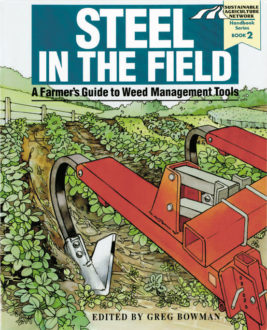Cultivation in Context: Renewed tools for better farming
Spend less. Manage more. Take control.
Here’s a deal for you. Invest in a few pieces of well-chosen steel, diversify your crop mix for higher-value marketing, and harvest a higher return to your bottom line through big savings on herbicide.
Interested? I thought so.
Keep in mind, whether you farm 1 acre or 1,000 acres, you can save in many ways—not just in dollars and cents. The tools and techniques you read about in this book will also pay off in less liability, greater management flexibility, less trouble with herbicide-resistant weeds and reduced off-farm environmental impacts.
Thinking about weed control changed dramatically in the years following World War II. Scientists working for the Allies developed growth-regulating compounds known today as 2,4-D and MCDA. When these chemicals “leaked” into the biological research community, it soon became clear they could be formulated to kill broadleaf weeds and not harm corn. These herbicides helped to reduce the need for cultivation and led to greater plant populations per acre. Check planting in wide rows of aligned hills (to allow cultivating across rows) gave way to drilled corn in narrower rows.
Herbicides, affordable hybrid corn seed and inexpensive nitrogen fertilizers opened new production frontiers throughout the ’50s. The arrival in the ’60s of atrazine and other herbicides that provided control for a wide range of weeds led to the wholesale abandonment of mechanical weed control (MWC) in some areas.
Tough-to-mount and painfully-boring-to-operate cultivators frequently became fencerow architecture. Farm-country cultivating skills and wisdom dwindled as herbicides simplified decision-making. Researchers can trace the origin of herbicide-resistant weeds, as well as “new” weeds, to the very areas where cultivation ceased.
However, mechanical weed control is still important to many farmers. While national aggregate sales of cultivating equipment slowly declined through the ’80s and ’90s, use of cultivators remains fairly common in scattered areas. Many farmers cultivate in some row-cropping regions of the Midwest and South. Vegetable farmers, especially in California, keep farmshop welders at work creating custom tools that fit their specialized needs. And ridge-till farming (see page 34) usually means at least an annual ridge-forming cultivator pass.
The current interest in mechanical and flame weed control tools as a preferred technology began long ago with farmers who decided—for a range of reasons—not to abandon their “steel” for herbicides. A few individuals never switched. Many contemporary tool users blend physical and chemical weed management modes. Some depend primarily on mechanical controls, using partial rates or “banding” herbicide in a swath just over the row area. Others use full broadcast rates and continue to cultivate to ensure top yields—or just because it feels right.
While the “other-than-herbicide” group of farmers has grown significantly in the past 30 years, it is still a distinct minority. Yet, out of necessity, these farmers have preserved weed management skills and developed sophisticated tools to produce crops profitably.
Steel used appropriately can cut herbicide costs. But an integrated mechanical tool approach wins in other ways, too. It deals effectively with herbicide-resistant weeds, perennial weeds in no-till fields, and soil types that respond positively to occasional tillage within a no-till system. Mixing in the optimum combination of tools and cultural weed management preserves the effectiveness of herbicides through limiting their use. When farmers bring together improved tools with all these factors, many find that an integrated, steel-based approach is their least risky, most profitable option.
There are even signs of a watershed in how mainline agricultural researchers will view the weed control future. Orvin C. Burnside is a veteran weed scientist at the University of Minnesota. In 1993, he authored a perspective piece titled “Weed Science—The Step Child” (Weed Technology, Vol. 7, Issue 2, pp. 515-518). He wrote:
Public weed scientists need to undertake a “crash program” to develop alternative weed control technologies that will be needed if herbicide use is reduced because of the economics of weed management, public concern, or government regulation. There needs to be a paradigm shift away from over dependence on herbicides that presently are our primary weapons in weed control.
Later, Burnside called for a systems approach using preventive, mechanical, cultural, biological, chemical and integrated strategies in his address to the North Central Weed Science Society’s 1995 annual meeting.
If these professionals pursue research into biological and mechanical strategies as aggressively as they have herbicides, many farmers featured in this book are ready to help. These visionary, self-funded agriculturists have practical, farm-tested techniques to share and plenty of new ideas to test and refine.
Expectations of tillage have changed dramatically in 50 years. Farmers are under critical scrutiny from their neighbors and regulators to keep streams clean and topsoil in place. Yet, as they devote more management to meet rising environmental standards, farmers wonder how to find new ways to make their operation profitable.
To win acceptance in the ’90s by farmers who know it only by its negative reputation, mechanical weed control has to show it can meet these challenges. This strategy has its own demands and limits, but also offers its own assurances. Through market incentives or crop diversification options, some operators decide that the benefits of not using herbicides justify the trade-off of mastering broader management skills. Other operators see well-managed herbicides and steel tools as equally useful and acceptable, and invest in learning how to fine-tine the combination.
